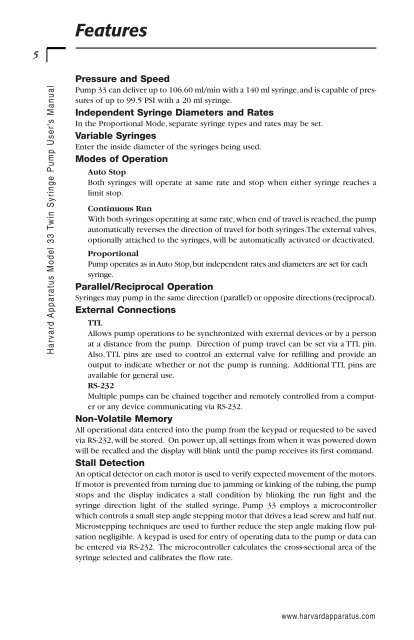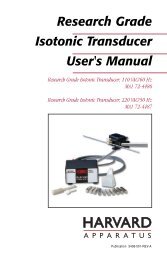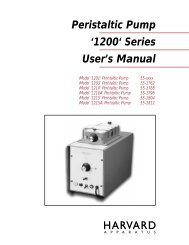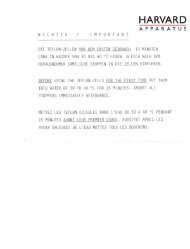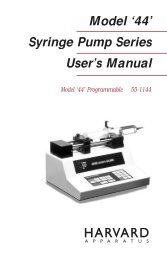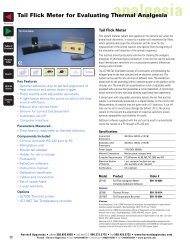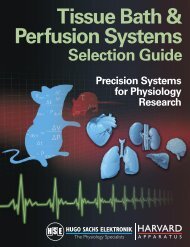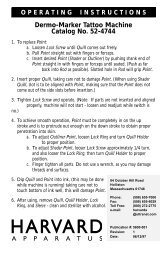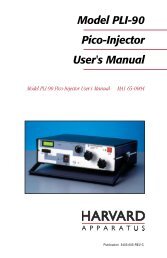Model 33 Twin Syringe Pump User's Manual - Harvard Apparatus
Model 33 Twin Syringe Pump User's Manual - Harvard Apparatus
Model 33 Twin Syringe Pump User's Manual - Harvard Apparatus
Create successful ePaper yourself
Turn your PDF publications into a flip-book with our unique Google optimized e-Paper software.
Features<br />
5<br />
<strong>Harvard</strong> <strong>Apparatus</strong> <strong>Model</strong> <strong>33</strong> <strong>Twin</strong> <strong>Syringe</strong> <strong>Pump</strong> <strong>User's</strong> <strong>Manual</strong><br />
Pressure and Speed<br />
<strong>Pump</strong> <strong>33</strong> can deliver up to 106.60 ml/min with a 140 ml syringe,and is capable of pressures<br />
of up to 99.5 PSI with a 20 ml syringe.<br />
Independent <strong>Syringe</strong> Diameters and Rates<br />
In the Proportional Mode, separate syringe types and rates may be set.<br />
Variable <strong>Syringe</strong>s<br />
Enter the inside diameter of the syringes being used.<br />
Modes of Operation<br />
Auto Stop<br />
Both syringes will operate at same rate and stop when either syringe reaches a<br />
limit stop.<br />
Continuous Run<br />
With both syringes operating at same rate,when end of travel is reached,the pump<br />
automatically reverses the direction of travel for both syringes.The external valves,<br />
optionally attached to the syringes, will be automatically activated or deactivated.<br />
Proportional<br />
<strong>Pump</strong> operates as in Auto Stop,but independent rates and diameters are set for each<br />
syringe.<br />
Parallel/Reciprocal Operation<br />
<strong>Syringe</strong>s may pump in the same direction (parallel) or opposite directions (reciprocal).<br />
External Connections<br />
TTL<br />
Allows pump operations to be synchronized with external devices or by a person<br />
at a distance from the pump. Direction of pump travel can be set via a TTL pin.<br />
Also, TTL pins are used to control an external valve for refilling and provide an<br />
output to indicate whether or not the pump is running. Additional TTL pins are<br />
available for general use.<br />
RS-232<br />
Multiple pumps can be chained together and remotely controlled from a computer<br />
or any device communicating via RS-232.<br />
Non-Volatile Memory<br />
All operational data entered into the pump from the keypad or requested to be saved<br />
via RS-232, will be stored. On power up, all settings from when it was powered down<br />
will be recalled and the display will blink until the pump receives its first command.<br />
Stall Detection<br />
An optical detector on each motor is used to verify expected movement of the motors.<br />
If motor is prevented from turning due to jamming or kinking of the tubing,the pump<br />
stops and the display indicates a stall condition by blinking the run light and the<br />
syringe direction light of the stalled syringe. <strong>Pump</strong> <strong>33</strong> employs a microcontroller<br />
which controls a small step angle stepping motor that drives a lead screw and half nut.<br />
Microstepping techniques are used to further reduce the step angle making flow pulsation<br />
negligible. A keypad is used for entry of operating data to the pump or data can<br />
be entered via RS-232. The microcontroller calculates the cross-sectional area of the<br />
syringe selected and calibrates the flow rate.<br />
www.harvardapparatus.com


